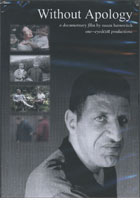
Without Apology 2004
Distributed by Without Apology
Produced by One~eyedcat productions
Directed by Susan Hamovitch
DVD, color, 73 min.
Adult
Disability Studies
Date Entered: 05/18/2007
Reviewed by Meghann Matwichuk, Morris Library, University of DelawareIn Without Apology, filmmaker Susan Hamovitch presents a very personal meditation on the radically divergent paths she and Alan, her developmentally disabled brother, have taken in life. Her poetic musings give voice to her deceased mother’s thoughts as well as her own starkly honest soul-searching questions and musings. Hamovitch explores the myriad contradictions made evident in family members’ reminiscences and in her own psyche as she comes to terms with Alan’s institutionalization as a young boy. Her family’s experience also reflects the greater historical and cultural influences at work in decades past, when developmental disabilities were poorly understood and few resources were made available for long-term treatment and care. Susan’s father talks about how doctors routinely blamed his wife for her son’s afflictions, citing her presumed detachment and emotional coldness as factors. A great companion piece for this film would be the documentary Refrigerator Mothers (Fanlight Productions, 2002), which tells the story of seven mothers of autistic children who coped with this ill-informed diagnosis.
Alan is introduced in the opening scenes with a series of strikingly direct questions (“Do I like you?”) and basic facts. At the time of the film’s release, he is a 43 year old man living on Social Security payments in a shared residence with other handicapped men, and is unable to speak or otherwise relate to those around him. Susan recalls the many varying diagnoses that were doled out throughout his life, ranging from clinical (autism, epilepsy) to downright cruel (“idiot”, “imbecile”). Home movies and photographs document Alan’s formative years, while family members recall the challenges his parents – most especially his mother – faced in raising him and his younger sister. Susan describes the shame and silence that permeate any past discussion of her brother and the decision to institutionalize him at the age of eight (when she herself was six years old). This makes her revealing on-camera discussions with her father, whom she describes as an intimidating man, all the more painful and poignant. Although the family visited Alan often, their activities were relegated events which could take place in social isolation, such as picnics in the park. A restaurant meal would be out of the question, given his erratic motions and loud outbursts. The viewer is directly involved in the narrative, experiencing Susan’s revelations right alongside her and coming to know her brother under the camera’s watchful gaze.
Alan’s condition is never definitively diagnosed, although it may be traceable to his contraction of encephalitis as a baby. What is documented, thoroughly, are his years at a sorely understaffed state-run facility called Letchworth Village, which was eventually shut down as the civil rights movement for the developmentally disabled began to gain momentum. Its idyllic country location in the Catskills belies the horrific conditions within. The most powerful scene in the film comes as Susan receives reams of records detailing Alan’s life from a caseworker; “So much has been said about him, and yet [my parents and I] couldn’t fill a page.” Her powerful realization that he is a “real human being” who experiences emotions and desires crashes over her. Once Alan has transitioned from Letchworth to a group home, where he receives greater one-on-one attention, improvements follow quickly. The final scene follows the pair as they take their first awkward yet touching steps toward reconciling their newfound relationship: Susan takes Alan out for ice cream at a family restaurant – an event that would not have been possible during their younger years.
It is easy for a documentarian to fall into certain traps when presenting a topic that is of personal importance to him or her. Hamovitch sidesteps these pitfalls, drawing her viewers close enough to relate to her family’s trials on a personal level while providing the frankness and honesty necessary to present an objective (albeit emotional) assessment of their difficult decisions. Always present are the shifting societal undercurrents at work re: institutionalization, medical diagnoses, and the increasing acceptance of those with developmental conditions in everyday life. These various elements come together to create a multi-faceted portrait of one family’s struggle over the decades to come to terms with developmental disabilities.